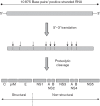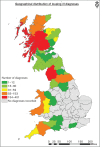Louping ill virus: an endemic tick-borne disease of Great Britain
- PMID: 24552787
- PMCID: PMC4811648
- DOI: 10.1099/vir.0.062356-0
Louping ill virus: an endemic tick-borne disease of Great Britain
Abstract
In Europe and Asia, Ixodid ticks transmit tick-borne encephalitis virus (TBEV), a flavivirus that causes severe encephalitis in humans but appears to show no virulence for livestock and wildlife. In the British Isles, where TBEV is absent, a closely related tick-borne flavivirus, named louping ill virus (LIV), is present. However, unlike TBEV, LIV causes a febrile illness in sheep, cattle, grouse and some other species, that can progress to fatal encephalitis. The disease is detected predominantly in animals from upland areas of the UK and Ireland. This distribution is closely associated with the presence of its arthropod vector, the hard tick Ixodes ricinus. The virus is a positive-strand RNA virus belonging to the genus Flavivirus, exhibiting a high degree of genetic homology to TBEV and other mammalian tick-borne viruses. In addition to causing acute encephalomyelitis in sheep, other mammals and some avian species, the virus is recognized as a zoonotic agent with occasional reports of seropositive individuals, particularly those whose occupation involves contact with sheep. Preventative vaccination in sheep is effective although there is no treatment for disease. Surveillance for LIV in Great Britain is limited despite an increased awareness of emerging arthropod-borne diseases and potential changes in distribution and epidemiology. This review provides an overview of LIV and highlights areas where further effort is needed to control this disease.
Figures



References
-
- Adam K. M., Beasley S. J., Blewett D. A. (1977). The occurrence of antibody to Babesia and to the virus of louping-ill in deer in Scotland. Res Vet Sci 23, 133–138. - PubMed
Publication types
MeSH terms
LinkOut - more resources
Full Text Sources
Other Literature Sources
Medical

